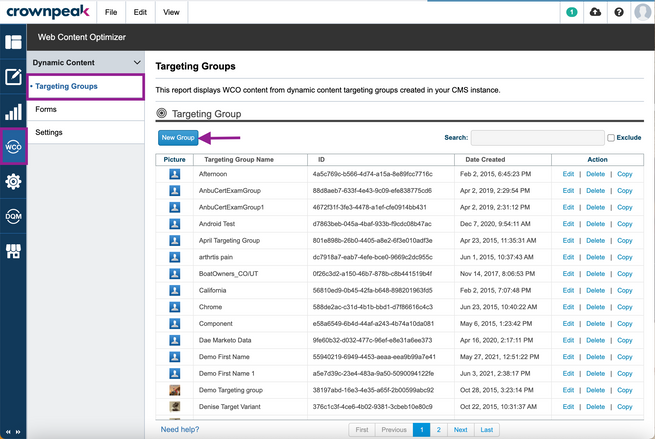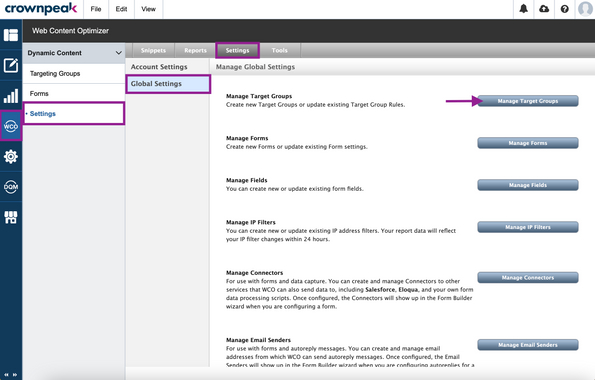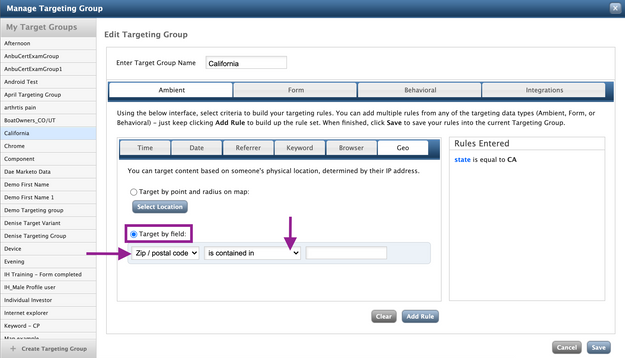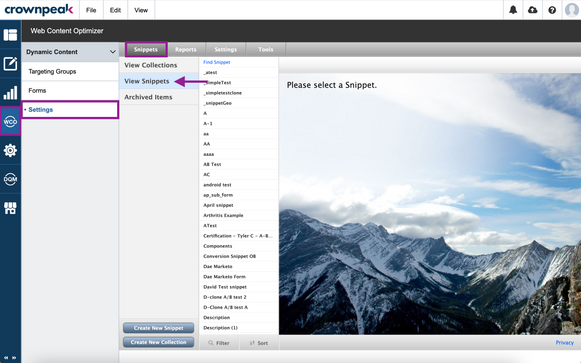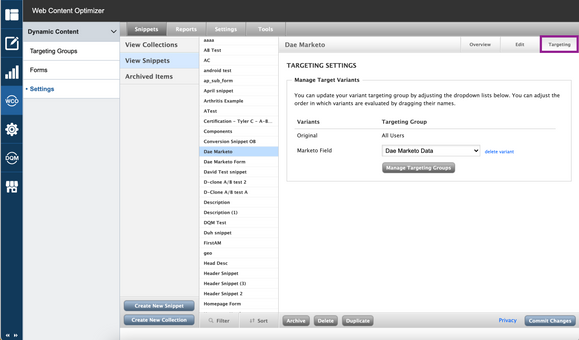Targeting groups
You can use targeting groups to help your website visitors focus on items of interest. For example, displaying an East Coast conference to a website visitor from Vermont.
Targeting groups overview
Targeting groups describe which visitors can see your content, based on a set of targeting rules or conditions that you specify and whether or not they match these conditions.
For example, you can deliver optimized and personalized content to visitors who:
- Visit your site on a specific date or at a specific time of day
- Visit your site on certain devices or browsers
- Visit your site from certain sources (search engine, social media sites) or geolocations (regions, states, countries and zip codes)
- Have viewed or interacted with certain parts of your site
- Have filled out a form and entered or selected certain field values
- Have a profile in your backend systems or any third party CRM or Marketing automation platform
DXM offers the best experience to manage, optimize and personalize your visitors’ web experience, directly in DXM since it:
- Is fully and directly integrated in the CMS authoring experience
- Leverages a simple drag and drop user interface to ensure ease of use
- Requires NO reading, editing, or copying of code
- Is designed to integrate with third party systems such as CRM’s and Marketing Automation Systems
- Contains a number of the most popular Targeting Group examples to get you started
- Offers a large number of Targeting Rules to choose from including time, date, geolocation, browser, device, form fields, querystring parameters, page views and conversions, back office and 3rd party attributes, and more
- Can store hundreds of custom Targeting Groups and Targeting Rules combinations
- Measures your marketing campaign success via the Analytics and Optimization Dashboards
Targeting group benefits
Content authors and editors can vary snippet content that can be applied to Text and WYSIWYG controls, directly within your DXM content.
You can create and manage a targeting campaign by defining your content variants in a WCO snippet, and the associated targeting groups that describe the visitors you want to target. You can manage both new and existing targeting groups via the drag and drop feature, allowing you to select from a number of targeting rules to define the audience or persona they want to target.
Targeting rules
DXM's targeting rules fall into the following categories:
- Ambient - Data or attributes that are readily available for all visitors including anonymous visitors
- Source - This data describes how the visitor arrived at your site
- Demographic -This data shows what is known about the user from their web connection
- Behavioral - This data describes the visitor’s interactions and engagement level on your site by tracking page views, and conversions
- Form - This data is collected from any form on your site
- Integration - This data is retrieved from your backend system, or any 3rd party system via WCO’s connectors
To learn more about targeting rules, see WCO Targeting Rules Explained.
DXM provides the following targeting rules to create your targeting groups with:
# Rule Type Use Case Example| 1 | Time | Targets users based on time of day they visit the site | Target "at work" visitors if they visit during the day and "at home" if they visit in the evening |
| 2 | Date | Target users based on date or date-range they visit the site | Deliver content before, after or during a campaign; or target a specific holiday |
| 3 | Device | Target user based on device and browser or on a custom condition in their browser agent | Deliver relevant content to iPhone or Safari users or based on their specific operating system, browser or type of device. This rule checks the user agent string. |
| 4 | Referrer | Target users based on the previous site they were on prior to arriving at yours | Identify users from search engines, social media sites or partner sites |
| 5 | Location | Identify and target users from specific regions, states, countries or zip code ranges | Target users in Texas |
| 6 | Snippet | Target users who view any snippet on any page in your site | Track user interest based on pages viewed |
| 7 | DemandBase* | Target users with specific DemadBase attributes based on their IP address | Identify competitors, partners, and/or potential customers in various industry segments |
| 8 | Marketo* | Target users based on their Marketo profile | Optimize your visitor's site experience with data from Marketo |
*Require third party integration
This version of the WCO targeting groups includes a number of common targeting group examples to get you started:
# Targeting Group Name Use Case Example
| 1 | iPhone Users | Identify users visiting the site on their iPhone | Promote your iPhone app to iPhone users |
| 2 | Android Users | Identify users visiting the site on any Android device | Display store location information to Android users |
| 3 | Mobile Users | Identify users visiting the site on any mobile device | Display store location information to mobile visitors |
| 4 | iPad Users | Identify users visiting the site on their iPad | Promote your iPad app to iPad users |
| 5 | IE Users | Identify users visiting the site using the IE browser | Deliver optimized CSS or JS based on IE version |
| 6 | Chrome Users | Identify users visiting the site using the Chrome browser | Deliver optimized CSS or JS based on Chrome version |
| 7 | Safari Users | Identify users visiting the site using the Safari browser | Deliver optimized CSS or JS based on Safari version |
| 8 | US Visitors | Identify visitors from the US | Deliver contents exclusive to US visitors |
| 9 | EU Visitors | Identify visitors from the EU | Deliver contents exclusive to EU visitors |
| 10 | Canadian Visitors | Identify visitors from Canada | Deliver contents exclusive to Canadian visitors |
| 11 | East Coast Visitors | Identify visitors from the East Coast of the US | Deliver special announcements and notifications |
| 12 | West Coast Visitors | Identify visitors from the West Coast of the US | Deliver special announcements and notifications |
| 13 | Google Visitors | Identify visitors who conducted a Google Search prior to arriving at your site | Highlight Site Navigation and Site Search to help Google Visitors find the content they're looking for |
| 14 | Bing Visitors | Identify visitors who conducted a Bing Search prior to arriving at your site | Highlight Site Navigation and Site Search to help Bing visitors find they content they’re looking for |
| 15 | Yahoo Visitors | Identify and target visitors who conducted a Yahoo Search prior to arriving at your site | Highlight Site Navigation and Site Search to help Yahoo visitors find they content they're looking for |
| 16 | Facebook Visitors | Identify visitors who engaged with your Social Media campaign that redirected them to your site | Extend offers to Facebook visitors |
| 17 | Twitter Visitors | Identify visitors who engaged with your Social Media campaign that redirected them to your site | Extend offers to Twitter visitors |
| 18 | LinkedIn Visitors | Identify visitors from LinkedIn who would like to learn more about your company | Redirect LinkedIn visitors to About Us page or Careers section |
Launching target groups
In Form Mode
- From the File View, navigate to and open an asset in Form view.
- Locate any WCO control in the form. WCO controls are easy to identify as they are labeled accordingly.
- If you already have a snippet, skip to step 6. Otherwise click Create Snippet to create a new snippet. Enter a snippet name when prompted. Alternatively, you may attach an existing snippet from the snippet drop-down.
- Click Add Targeting Variantto define a new content variant.
- Enter a name for your new variant.
- Associate the variant with a targeting group either by selecting one from the drop-down, or by clickingCreate Targeting Group,which will launch WCO's targeting groups interface.
Note: Refer to the Creating and editing a targeting group section below for detailed instructions on how to create a new targeting group. - Once created, the targeting group will be available for selection from the targeting group drop-down.
WCO Targeting Group drop-down - Enter your optimized content for your newly created and/or selected targeting group.
Creating and editing a targeting group
Before creating a targeting group, ensure that you've launched a targeting group from the desired asset(s). See above instructions if necessary.
- To create a new targeting group, navigate to the WCO menu > Targeting Groups.
- Click New Group. To edit an existing targeting group, click Edit next to one of the pre-existing groups in the list.
New Targeting Group - From the Targeting Group fields, enter a Group Name.
- (Optional) Add an image for the Targeting Group.
a. Click the profile photo.
b. In the Upload Photo window, select Browse.
c. Select an image from your computer and click Open.
d. In the Upload Photo window click Upload.
e. The selected image will display for your targeting group. - Select from the list of New Fields or custom Existing rule types.
- Drag the desired rules(s) into the targeting group.
- ClickEditnext to each new rule and enter the rule criteria.
- When finished, click Save. The targeting group will be ready to use in DXM.
Adding multiple zip codes to your geo target group
- From the WCO menu, navigate to Settings > Global Settings > Manage Target Groups.
Manage Target Groups - Select the target group that you wish to edit.
- Navigate to the Ambient > Geo menus.
- Select the Target by field radio button, and from the drop-down select Zip/postal code and is contained in for multiple zip codes.
Target by zip code field - Enter your zip codes.
- Click Add Rule.
Note: For a singular zip code, select is equal to from the drop-down.
Changing variant priority
Background
When it comes to targeting variants, WCO will start at the top of your list, and stop matching variants after a match is found. In the in-context or form edit view, the only way to re-order which variant is at the top of the list is to delete and re-add variants to achieve the order you’re interested in.
Solution
There's a much easier way to change variant priority, which can be accomplished with the following steps:
- In DXM, navigate to WCO > Settings > Snippets > View Snippets.
DXM WCO View Snippets button - Select the snippet you’d like to reorganize.
- Click Targeting.
DXM WCO Snippets Targeting settings - Hover over the variant you’d like to move until your cursor changes into a double-sided vertical arrow.
- Click and drag to move variants into their new positions.
- When finished, click Commit Changes.
Personalizing content - cookies
The following contains a listing and general information about cookies stored by WCO:
Cookie Name: a
Cookie Domain: snippet.omm.crownpeak.com
The "a" cookie keeps track of IP address recorded for this client's OmmAnonId.
Cookie Name: OmmAnonId
Cookie Domain: .omm.crownpeak.com
The "OmmAnonId`" is a GUID used as the key to the users identity
Cookie Name: ASP.NET_SessionId
Cookie Domain: snippet.omm.crownpeak.com
The "ASP.NET_SessionId" is the session cookie used by WCO
Cookie Name: OmmValues80112474-504a-4bcb-9f86-e212c0b0039a
Cookie Domain: .omm.crownpeak.com
The "OmmValues(key)" is a unique identifier to the specific snippet the cookie is related to.
Note: Cookies do not expire.
Tips and tricks
Does WCO support AND and OR logical operations?
- Most WCO Targeting Rules support an [Is Contained In] and [Is Not Contained In] logical operations which allow you to define any number of values you would like to match against. These values should be clearly delimited by a space, comma, or a pipe.
Examples:
Demographic: Geo-Location: State is contained in CA, NY, TX
Form: Field Value: JobTitle is contained in “Marketer”, “Project Manager”, “IT Developer - Certain Ambient attributes such as Browser and Device provide checkboxes to select from. You may choose one or more checkboxes with an implied OR
Examples:
Ambient: Browser: Chrome, Safari, IE
Ambient: Device: iPhone, Android, Blackberry - Behavioral attributes natively support OR operations due to the parent/child relationship between Snippets and their variants, as well as between Variants and embedded Conversion links., by selecting the parent snippet which will report on all embedded variant views (essentially an OR between the variants), or by selecting a variant which will report on all embedded conversion links (essentially an OR between the conversion links).
Examples:
Behavioral: Views: all variants of a particular snippet (essentially an OR between the variants)
Behavioral: Conversions: all conversions of a particular variant or snippet (essentially an OR between all the conversion links) - WCO also allows you to repeat the same variant, as many times as you like within a snippet. These identical variants can be associated with any Targeting Group, allowing you to deliver the same content to different target audiences.
WCO recognizes any custom parameters included in the snippet’s Javascript call, and exposes these parameters for targeting purposes as Form Field values.
This capability is extremely useful in instances where you need to pass user profile specific attributes to WCO in real-time, or asset specific parameters to the WCO snippet.
Note: This data is not stored in WCO and will not impact your conversion counts. For example, let’s say we need to pass the label or the page that is delivering the WCO snippet. To add this custom real-time attribute to WCO, add the following code to your Output Template:
<%= asset["wco_snippet"].Replace("\" ></script>", "?asset =” + asset.Label + “\" ></script>")%>
The code above will produce the following output:
<script type="text/javascript" src="//snippet.omm.crownpeak.com/s/2c4764a1-b91d-4d37-9aeb-eaabecfa2fc2?asset=Homepage" ></script>
The custom attribute will now be targetable in WCO as a Form Field Value.
How to preview my optimized experiences in DXM?
DXM provides an intuitive interface directly within the authoring experience to preview your content variations for each of the Targeting Groups you’ve defined.
While previewing and/or editing an asset, the [Overview] panel, found in the right side Accordion includes a new [Profile] tab which lists all of the Targeting Groups used on the page. Clicking on any Profile (which is the same as a Targeting Group), will result in re-rending the page in real-time reflecting what the targeted audience would see
How to test geo-location, browser, and device optimized experiences in a browser?Besides testing and validating the content and web experience in Preview mode directly in the CMS, as described in previous tip, you can also test the experience post-publishing in your supported browsers, and devices. You may also test the content and experience from various geographical locations.
To simulate visiting the site from different devices and browsers:
Look for browser extensions that facilitate changing the browser’s User Agent to simulate different devices and browsers.
To simulate visiting the site from geographical locations:
Look for browser extensions that provide Proxy and VPN functions which will simulate visiting the site from different geographical locations.

